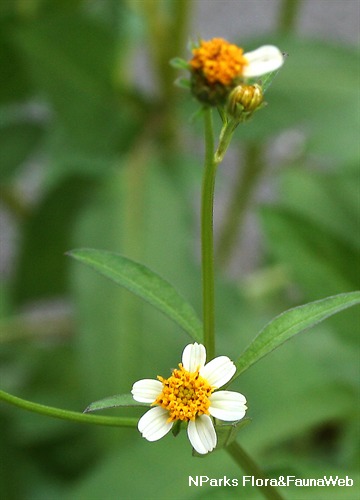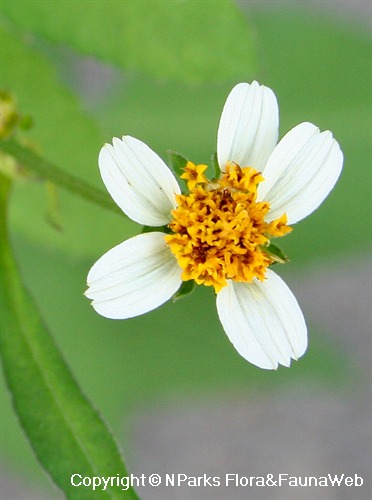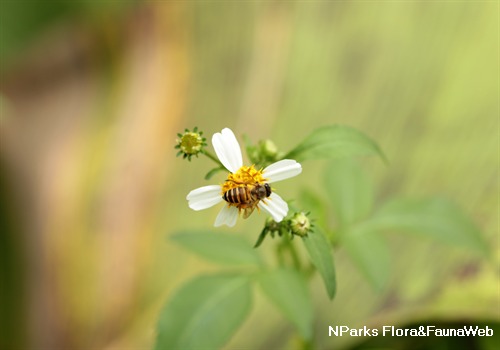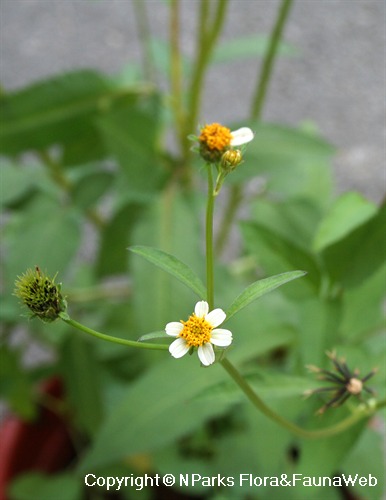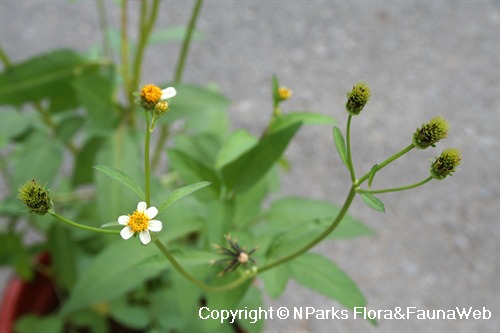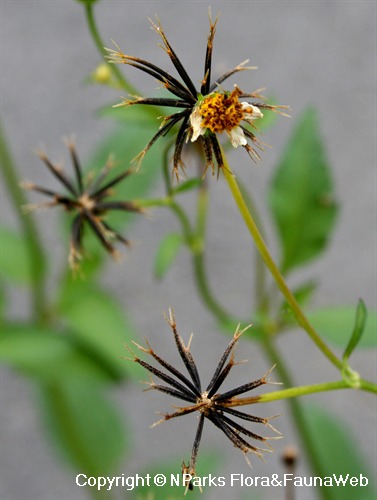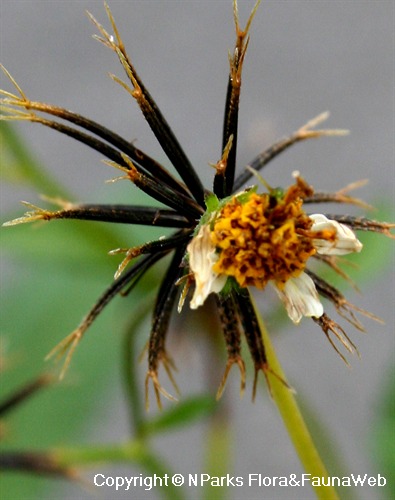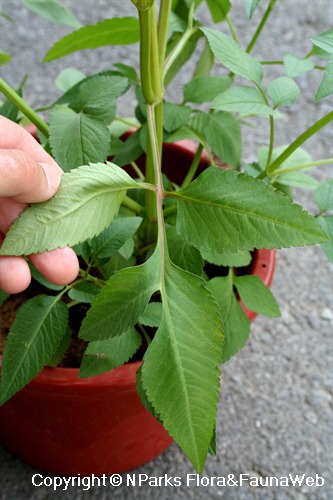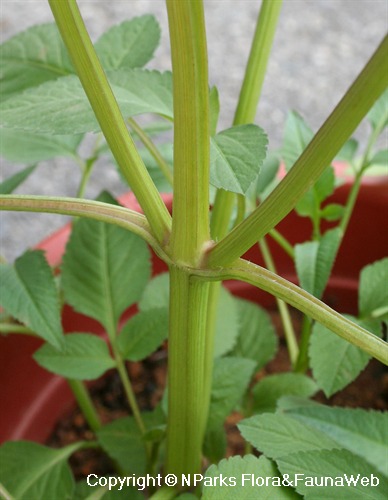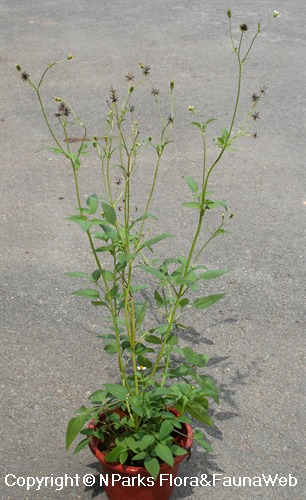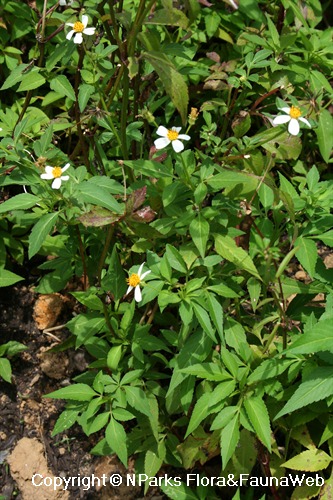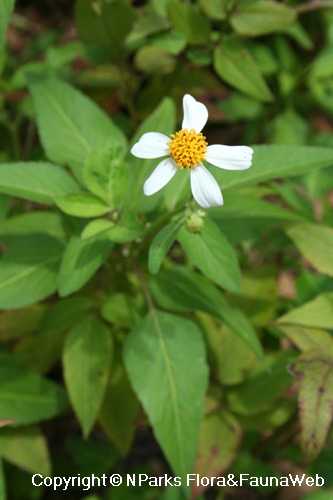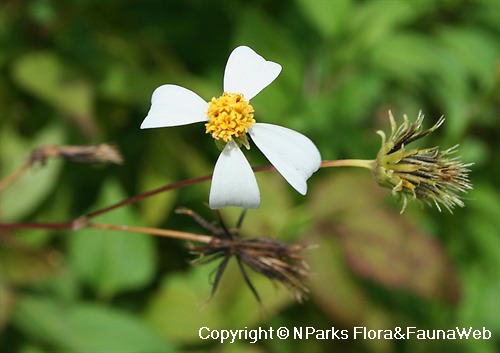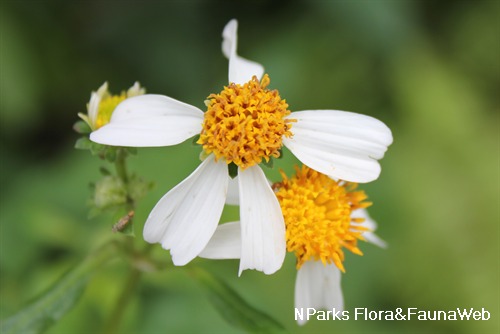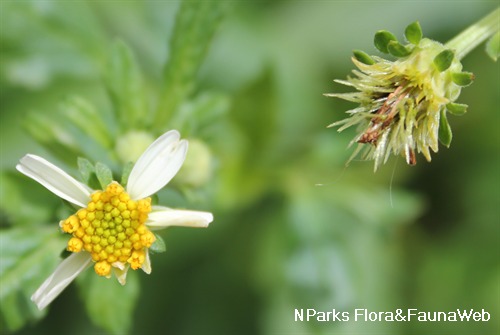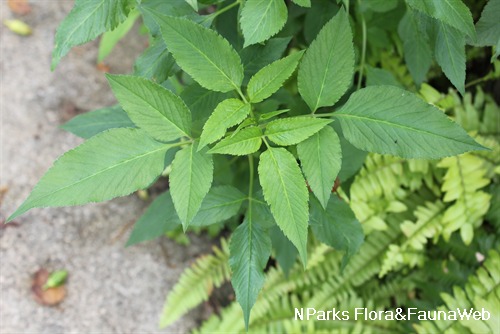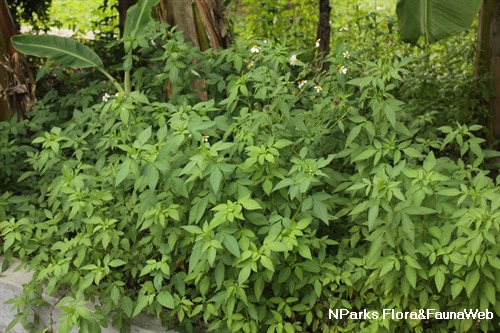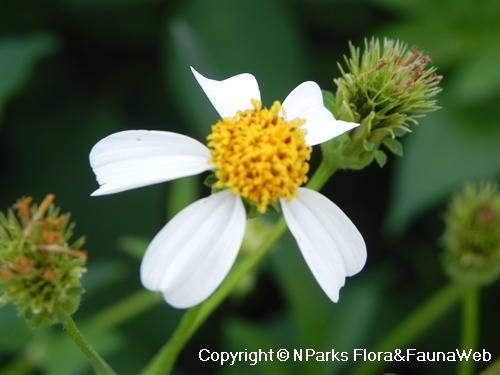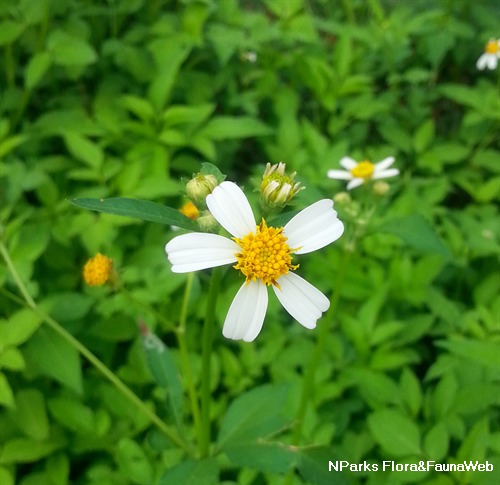
Back
Bidens pilosa L.
| Family Name: | Asteraceae (Compositae) |
| Synonyms: | Bidens sundaica var. minor, Bidens pilosa var. bimucronata, Bidens pilosa var. minor |
| Common Name: | Beggar's Tick, Begger's Tick, Hairy Beggarticks, Spanish Needles, Black Jack, Bur Marigold, Pitchforks, Stick Tight, 小白花鬼针, 鬼针草 |
Name
Classifications and Characteristics
| Plant Division | Angiosperms (Flowering Seed Plants) (Dicotyledon) |
|---|---|
| Plant Growth Form | Herbaceous Plant |
| Lifespan (in Singapore) | Annual |
| Mode of Nutrition | Autotrophic |
| Plant Shape | Irregular |
| Maximum Height | 1.5 m to 2 m |
Biogeography
| Native Distribution | Mexico, Central Americas, Caribbean, Tropical & Sub-tropical South America |
|---|---|
| Native Habitat | Terrestrial (Disturbed Area / Open Ground) |
| Preferred Climate Zone | Tropical, Sub-Tropical / Monsoonal |
Description and Ethnobotany
| Growth Form | Annual herb up to 2 m tall or more. |
|---|---|
| Foliage | Leaves trifolately-compound, with serrate margins and velvety texture; terminal leaflet may be asymmetrically-lobed. |
| Stems | Squarish in cross-section. |
| Flowers | Produced as inflorescence heads at top of branched stalks. 2 types of inflorescences: Radiate heads 2cm across with central yellow disc florets and 4-7 white ray florets ("petals") 2-8mm long; and Discoid florets which consist only of disc florets with no ray florets. Source of nectar for butterflies. |
| Fruit | Bristly, achenes (one-seeded fruits) with mainly 3 awns (barbed hooks) at tip, black when mature, sticking onto fur or feathers and dispersed by browsing fauna. |
| Habitat | Resident of infertile open wastelands and disturbed areas in native regions. Widely naturalized throughout world as pantropical and crop weed. Recorded as fairly common in hilly areas of Peninsular Malaysia, and occasionally seen in Singapore. |
| Similar | Resembles Bidens alba, which has similarly white ray florets. But latter species is differentiated by longer ray florets (6-16 mm), absence of discoid florets, and chiefly 2-hooked awns at tips of achenes. |
| Cultivation | Drought-tolerant plant. Propagate by seeds. Handle with caution - some individuals may be sensitive to phyto-toxic compounds in plant, which upon contact with skin, may cause irritation if exposed to sunlight. |
| Etymology | Genus epithet 'Bidens' means 'twice' (bi) and 'toothed' (dens), a reference to the 2 bristles on the tip of the achene-seed of some members of this genus. Species epithet 'pilosa' means 'hairy', describing the velvety foliage. |
| Ethnobotanical Uses | Edible Plant Parts : Edible Leaves, Edible Flowers, Edible Stems Food (Herb or Spice) (Fruit or Vegetable): Plant is a good source of iodine, and has peppery or spicy taste. Tender leaves cooked as vegetable by poor people. Leaves added raw to salads or steamed in soups and stews. Young shoot tips brewed as tea. Flowers served with rice dishes. Medicinal: Traditional Medicinal Uses In traditional medicine, it is used to treat wounds, ulcers, thrush, rheumatism and intestinal disease. As this species accumulates toxic metals and arsenic in the soil, it would be important to ensure that plants intended for consumption came from a clean environment. <1> It is important to note that some therapeutic effects from traditional medicinal uses of plants are not currently supported or verified by scientific research. |
Landscaping Features
| Desirable Plant Features | Ornamental Flowers |
|---|---|
| Landscape Uses | Container Planting, General, Flowerbed / Border, Parks & Gardens |
| Thematic Landscaping | Butterfly Garden, Naturalistic Garden, Wildflower Garden |
| Usage Hazard - Cons | Irritant - Sap |
| Usage Hazard - Cons Remarks | Parts of plant (esp. leaves, flowers, roots) are phyto-toxic. When sun-exposed skin is in contact with plant, may result in skin burning, irritation, swelling, pigmentation or lesions in sensitive individuals. |
Fauna, Pollination and Dispersal
| Fauna Pollination Dispersal Associated Fauna | Butterfly-Attracting, Bee-Attracting |
|---|---|
| Pollination Method(s) | Biotic (Fauna) (Insects (Butterfly, Moth), Insects (Bee), Insects (Ant, Beetle, Fly, Thrip, Wasp)), Abiotic (Self-Pollinated) |
| Seed or Spore Dispersal | Biotic (Fauna) (Vertebrates (Other Mammal), Vertebrates (Human)) |
Plant Care and Propagation
| Light Preference | Semi-Shade, Full Sun |
|---|---|
| Water Preference | Moderate Water |
| Plant Growth Rate | Fast |
| Rootzone Tolerance | Easy to Grow, Drought Tolerant, Fertile Loamy Soils, Well-Drained Soils, Moist Soils |
| Maintenance Requirements | Moderate |
| Propagation Method | Seed |
Foliar
| Foliage Retention | Evergreen |
|---|---|
| Mature Foliage Colour(s) | Green |
| Mature Foliage Texture(s) | Velvety / Furry / Tomentose |
| Foliar Type | Compound (Trifoliate) |
| Foliar Arrangement Along Stem | Opposite |
| Foliar Shape(s) | Non-Palm Foliage (Ovate) |
| Foliar Venation | Pinnate / Net |
| Foliar Margin | Serrate / Toothed |
| Foliar Apex - Tip | Acuminate |
| Foliar Base | Rounded / Obtuse |
| Typical Foliar Area | Notophyll ( 20.25cm2 - 45 cm2 ) |
Non - Foliar and Storage
| Stem Type & Modification | Herbaceous |
|---|---|
| Root Type | Underground (Fibrous Root) |
Floral (Angiosperm)
| Flower & Plant Sexuality | Bisexual Flowers |
| Flower Colour(s) | White, Yellow / Golden |
|---|---|
| Flower Grouping | Cluster / Inflorescence |
| Flower Location | Terminal |
| Inflorescence Type | Head / Capitulum |
| Flowering Period | Free-Flowering |
| Flowering Habit | Polycarpic |
Fruit, Seed and Spore
| Mature Fruit Colour(s) | Black |
|---|---|
| Fruit Classification | Simple Fruit |
| Fruit Type | Indehiscent Dry Fruit , Achene |
References
| References | <1> Xuan, T.D. & Khanh, T.D. (2016). Chemistry and pharmacology of Bidens pilosa: an overview. Journal of Pharmaceutical Investigation 46: 91-132. <2> Budumajji, U. & Solomon Raju A.J. (2018). Pollination ecology of Bidens pilosa L. (Asteraceae). Taiwania 63(2): 89-100. |
|---|
Image Repository
Others
| Master ID | 5960 |
|---|---|
| Species ID | 3312 |
| Flora Disclaimer | The information in this website has been compiled from reliable sources, such as reference works on medicinal plants. It is not a substitute for medical advice or treatment and NParks does not purport to provide any medical advice. Readers should always consult his/her physician before using or consuming a plant for medicinal purposes. |

